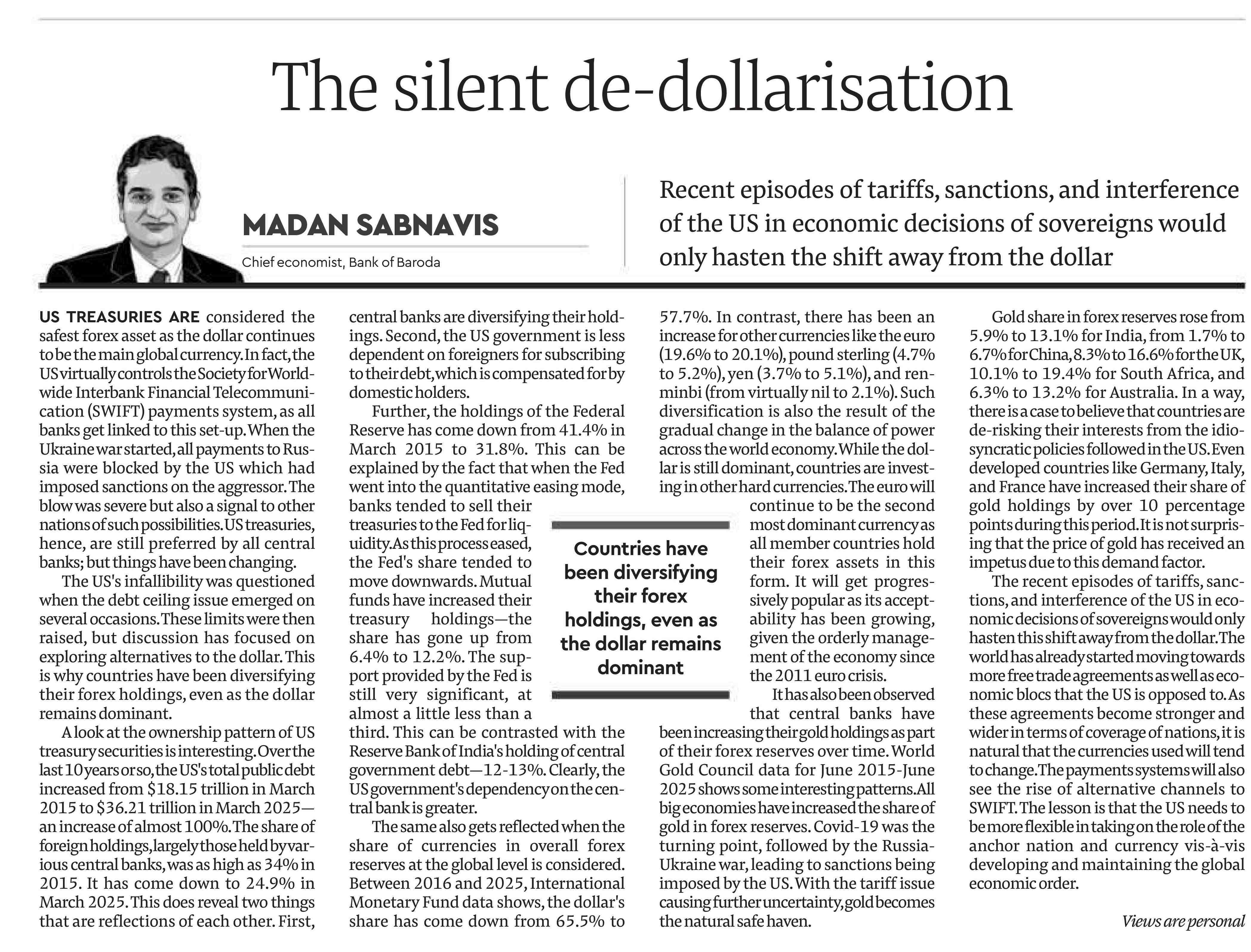The silent de-dollarisation
The silent de-dollarisation
MADAN SABNAVIS
Chief economist, Bank of Baroda
US TREASURIES ARE considered the
safest forex asset as the dollar continues
to be the main global currency. In fact, the
US virtually controls the Society for World-
wide Interbank Financial Telecommuni-
cation (SWIFT) payments system, as all
banks get linked to this set-up. When the
Ukraine war started, all payments to Rus-
sia were blocked by the US which had
imposed sanctions on the aggressor. The
blow was severe but also a signal to other
nations of such possibilities. US treasuries,
hence, are still preferred by all central
banks; but things have been changing.
The US's infallibility was questioned
when the debt ceiling issue emerged on
several occasions. These limits were then
raised, but discussion has focused on
exploring alternatives to the dollar. This
is why countries have been diversifying
their forex holdings, even as the dollar
remains dominant.
A look at the ownership pattern of US
treasury securities is interesting. Overthe
last 10 years or so, the US's total public debt
increased from $18.15 trillion in March
2015 to $36.21 trillion in March 2025-
an increase of almost 100%. The share of
foreign holdings, largely those held by var-
ious central banks, was as high as 34% in
2015. It has come down to 24.9% in
March 2025. This does reveal two things
that are reflections of each other. First,
central banks are diversifying their hold-
ings. Second, the US government is less
dependent on foreigners for subscribing
to their debt, which is compensated for by
domestic holders.
Further, the holdings of the Federal
Reserve has come down from 41.4% in
March 2015 to 31.8%. This can be
explained by the fact that when the Fed
went into the quantitative easing mode,
banks tended to sell their
treasuries to the Fed for liq-
uidity. As this process eased,
the Fed's share tended to
move downwards. Mutual
funds have increased their
treasury holdings-the
share has gone up from
6.4% to 12.2%. The sup-
port provided by the Fed is
still very significant, at
almost a little less than a
Countries have
been diversifying
their forex
holdings, even as
the dollar remains
dominant
third. This can be contrasted with the
Reserve Bank of India's holding of central
government debt-12-13%. Clearly, the
US government's dependency on the cen-
tral bank is greater.
The same also gets reflected when the
share of currencies in overall forex
reserves at the global level is considered.
Between 2016 and 2025, International
Monetary Fund data shows, the dollar's
share has come down from 65.5% to
Recent episodes of tariffs, sanctions, and interference
of the US in economic decisions of sovereigns would
only hasten the shift away from the dollar
57.7%. In contrast, there has been an
increase for other currencies like the euro
(19.6% to 20.1%), pound sterling (4.7%
to 5.2%), yen (3.7% to 5.1%), and ren-
minbi (from virtually nil to 2.1%). Such
diversification is also the result of the
gradual change in the balance of power
across the world economy. While the dol-
lar is still dominant, countries are invest-
ing in other hard currencies. The euro will
continue to be the second
most dominant currency as
all member countries hold
their forex assets in this
form. It will get progres-
sively popular as its accept-
ability has been growing,
given the orderly manage-
ment of the economy since
the 2011 euro crisis.
It has also been observed
that central banks have
been increasing their gold holdings as part
of their forex reserves over time. World
Gold Council data for June 2015-June
2025 shows some interesting patterns. All
big geconomies have increased the share of
gold in forex reserves. Covid-19 was the
turning point, followed by the Russia-
Ukraine war, leading to sanctions being
imposed by the US. With the tariff issue
causing further uncertainty, gold becomes
the natural safe haven.
Gold share in forex reserves rose from
5.9% to 13.1% for India, from 1.7% to
6.7% for China, 8.3% to 16.6% forthe UK,
10.1% to 19.4% for South Africa, and
6.3% to 13.2% for Australia. In a way,
there is a case to believe that countries are
de-risking their interests from the idio-
syncratic policies followed in the US. Even
developed countries like Germany, Italy,
and France have increased their share of
gold holdings by over 10 percentage
points during this period. It is not surpris-
ing that the price of gold has received an
impetus due to this demand factor.
The recent episodes of tariffs, sanc-
tions, and interference of the US in eco-
nomic decisions of sovereigns would only
hasten this shift away from the dollar. The
world has already started moving towards
more free trade agreements as well as eco-
nomic blocs that the US is opposed to. As
these agreements become stronger and
wider in terms of coverage of nations, it is
natural that the currencies used will tend
to change. The payments systems will also
see the rise of alternative channels to
SWIFT. The lesson is that the US needs to
be more flexible in taking on the role of the
anchor nation and currency vis-à-vis
developing and maintaining the global
economic order.
Views are personal

